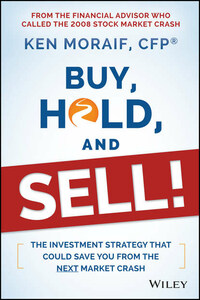Cover design: Wiley
Copyright © 2015 by Ken Moraif. All rights reserved.
Published by John Wiley & Sons, Inc., Hoboken, New Jersey.
Published simultaneously in Canada.
No part of this publication may be reproduced, stored in a retrieval system, or transmitted in any form or by any means, electronic, mechanical, photocopying, recording, scanning, or otherwise, except as permitted under Section 107 or 108 of the 1976 United States Copyright Act, without either the prior written permission of the Publisher, or authorization through payment of the appropriate per-copy fee to the Copyright Clearance Center, Inc., 222 Rosewood Drive, Danvers, MA 01923, (978) 750-8400, fax (978) 646-8600, or on the Web at www.copyright.com. Requests to the Publisher for permission should be addressed to the Permissions Department, John Wiley & Sons, Inc., 111 River Street, Hoboken, NJ 07030, (201) 748-6011, fax (201) 748-6008, or online at http://www.wiley.com/go/permissions.
Limit of Liability/Disclaimer of Warranty: While the publisher and author have used their best efforts in preparing this book, they make no representations or warranties with respect to the accuracy or completeness of the contents of this book and specifically disclaim any implied warranties of merchantability or fitness for a particular purpose. No warranty may be created or extended by sales representatives or written sales materials. The advice and strategies contained herein may not be suitable for your situation. You should consult with a professional where appropriate. Neither the publisher nor author shall be liable for any loss of profit or any other commercial damages, including but not limited to special, incidental, consequential, or other damages.
For general information on our other products and services or for technical support, please contact our Customer Care Department within the United States at (800) 762-2974, outside the United States at (317) 572-3993 or fax (317) 572-4002.
Wiley publishes in a variety of print and electronic formats and by print-on-demand. Some material included with standard print versions of this book may not be included in e-books or in print-on-demand. If this book refers to media such as a CD or DVD that is not included in the version you purchased, you may download this material at http://booksupport.wiley.com. For more information about Wiley products, visit www.wiley.com.
Library of Congress Cataloging-in-Publication Data:
Moraif, Ken.
Buy, hold, and sell!: the investment strategy that could save you from the next market crash / Ken Moraif.
pages cm
Includes index.
ISBN 978-1-118-95149-1 (hardback); ISBN 978-1-118-95151-4 (epdf);
ISBN 978-1-118-95150-7 (epub)
1. Investments. 2. Retirement income– Planning. 3. Investment analysis. I. Title.
HG4521.M837 2015
332.6– dc23
2014036990
I want to thank:
Money Matters' beloved and most valued clients.
The astute, inquisitive, and engaged listeners of my radio show.
The patient, long-suffering, and dedicated Cindy Brown, who put up with all of my quirks and calendar issues.
My three wonderful daughters, who never hesitate to criticize me and keep me on the straight and narrow.
And always, my beautiful, talented, and supportive wife Fay.
Introduction
One Bear Market Can Change Your Life Forever
How would you feel if you lost over 78 percent of your retirement investments in one bad market?
I'd been doing a weekly radio show for four years when I was asked to speak at the “Managing Your Money” conference in Arlington, Texas. After my presentation to some 4,000 attendees, I walked offstage to find a man in his late fifties waiting for me. He said, “Ken, glad to meet you. I listen to your radio show every week.”
“Thanks,” I said, shaking his hand.
“Do you know how much money I had before this last bear market?”
This was 2002. The tech bubble had recently burst. I was afraid this was going to be a sad story. “No,” I said, “how much did you have?”
“Three million dollars.”
“Wow, that's great,” I said. “Congratulations.”
“Do you know much money I have now?”
I shook my head, bracing myself.
“I have $650,000.”
I remember looking at the man. I couldn't believe he was standing, let alone smiling. “But tell me,” I said, “To go from $3 million to $650,000, you had to see your investments drop to $2.5 million, then $2 million, then one and half…There were signposts along the way. Why didn't you get off the ride?”
And he said, “I had every intention. I planned to get out if my investments ever dropped down to two and a half million. But when they went down that far, I thought to myself, ‘I'm down $500,000. I can't sell now. That'd be ridiculous.’”
I had the feeling I knew where he was going.
He continued: “So I drew a line in the sand: If my investments went down to $2 million, I'd sell for sure. But when they sank to that point, I did the same thing. I said to myself, ‘Oh no, I'm down $1 million. I can't sell now, because the market will come back. I don't want to be the fool who sells at the bottom.’”








